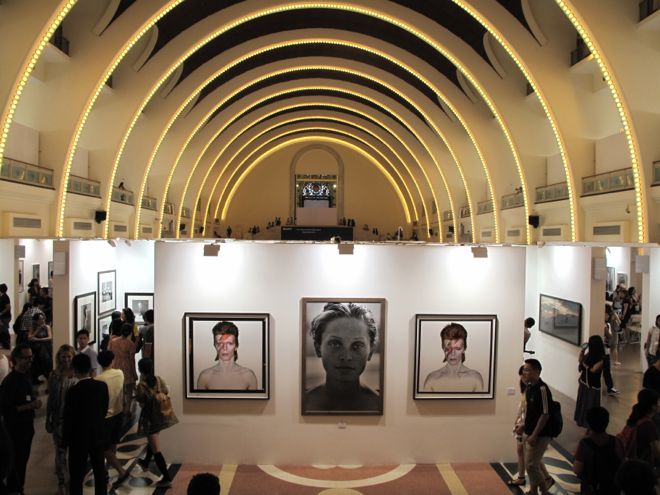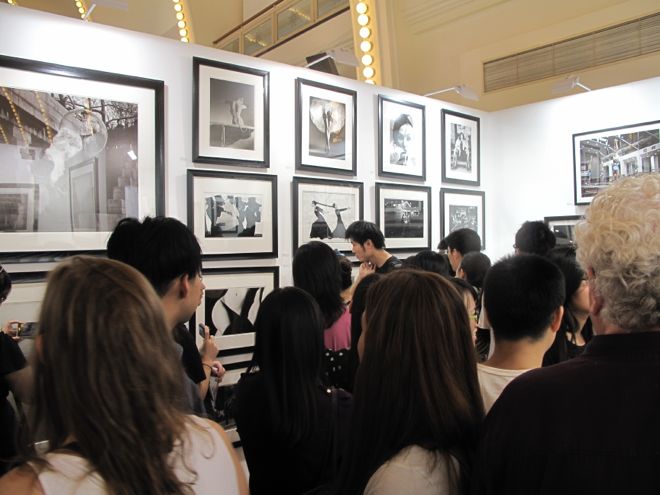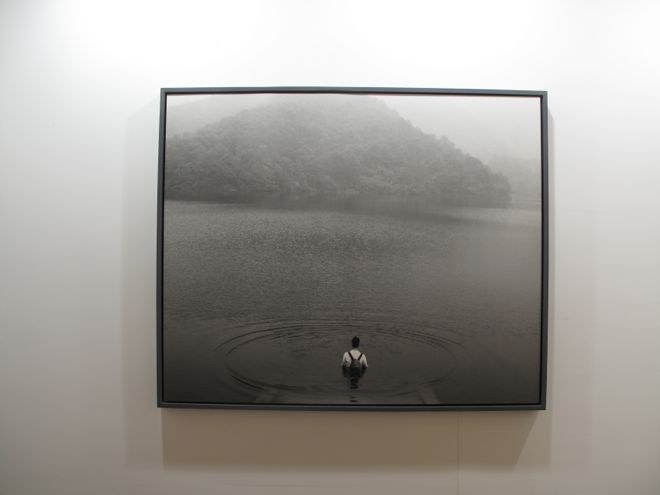This year, the onset of September signaled a headlong rush of art fairs in Shanghai (four this month alone). First off the mark was Photo Shanghai, a photography fair focused on the Asia-Pacific region and featuring about 40 galleries, Chinese and international. With effective promotion, efficient execution and a general high level of professionalism, the fair organizers won over general assent. The marvelous Soviet classical ambiance of the venue, with its lovely creamy turquoise ceilings and subtle ornamentation, certainly adds to the appeal.
“Shanghai has a cool, sexy reputation in the wider world,” Scott Gray, the managing director, explained, “We’ve looked all across Asia, but the elephant in the room was China. Hong Kong might be easier, Singapore might be easier, but in the end everyone wants China.”
Certainly, Photo Shanghai is no neophyte affair. A joint effort between the Montgomery Group and the World Photo Organization, Photo Shanghai also partners with the Modern Media Group, the Mainland publisher of Modern Weekly, Vision and LEAP magazines, among others. The Montgomery Group itself, meanwhile, has also had a hand in starting numerous fairs worldwide including London’s Art13 (Art14, Art15 and so on; the number changes by year), Istanbul’s ArtInternational, New Delhi’s India Art Fair and, of course, ArtHK before it was purchased by the ArtBasel empire (indeed, it is also behind another art fair in HK, Art Central, rumored to commence next year). In a way, then, an international caliber was to be expected.
On the VIP opening night, a good crowd showed up to look and learn. With the gallery breakdown being half international and half Asian (mostly Chinese), there was plenty for everyone. On the more iconic side, Peter Fetterman (Los Angeles) brought a curated Henri Cartier-Bresson selling exhibition opposite their gallery booth filled with iconic photojournalist prints (like “The Afghan Girl” by Steve McCurry). There was also an awful lot of fashion photography (at the Fahey Klein booth, for one), or images of celebrities like David Bowie (at Camera Works, Berlin). “It’s as though these galleries think they’re really art galleries,” an art magazine editor said rather sniffily.

柏林Camera Work展位
One general observation was how many of the international galleries seemed to have brought more palatable works, as though testing the waters, while the local Chinese galleries showed more confidence in works not geared towards fashion or photojournalism. A Thousand Plateaus showcased photographers from Chengdu; Li Lang had intriguing photographs overlaid with numerated dates (think On Kawara and Roman Opalka). Aike-Dell’Arco (Shanghai) had a photograph of Tang Dixin’s performance “Backpack” (Tang memorably jumped onto the tracks of the Shanghai subway, and also re-enacted Yves Klein’s “Saut dans le vide” in real life). Works by established artists like Yang Fudong made appearances in the ShanghART booth, while domestic stalwarts like Three Shadows and Pékin Fine Arts were also present. Of course, this is schematic. Atlas and Flowers had excellent booths. Meanwhile, Tristan Hoare (London) noticed how Momentum by Alejandro Guijarro, a photographic series of quantum physics blackboards, somewhat surprisingly aroused a good deal of interest.
That the fair happened at all was really something, considering the normal difficulties of operating in China (viz. that other fair). Yet the director Alexander Montague-Sparey noted that “The big challenge was the perception” of hosting the fair in China.
Aside from VIPs being invited to attend, the fair has invested time and effort in education, with a formidable series of lectures and forum discussions in the hope of nurturing and educating a collector base. As Scott Gray remarked, “Someone said, ‘Just send the JPEG over and I’ll print it myself.’ Well, it doesn’t work like that.”
On the days other than the opening night, Photo Shanghai was a victim of its own success (and of its over-liberal handout of tickets): people. People mountain, people sea, as the Chinese expression goes. There were people everywhere; sometimes you had to elbow your way through, and even then, someone was already standing there. I quietly rued not looking enough on the opening night. Shi Yong of ShanghART said on his WeChat, “Now this is a crowd! Photo Shanghai gives the expo a run for its money!” Anyone who has been to the 2010 Shanghai Expo can commiserate. Some gallerists also grumbled about how collectors couldn’t even see the works properly. (Also, rather like at the Expo, foreigners at large were objects of fascination. And a male laowai with a baby? Catnip to shutterbugs. I witnessed an incredible scrum of dozens of photographers snapping away at the baby.)
“The crowds are testament to what we’ve achieved,” Montague-Sparey intoned, before adding, “Certainly, the ticket prices will go up next year.”

艺博会场景

艺博会场景
To be fair, any organizer would want the event to be accessible and yet reasonably sane. Of course, everyone knows that there are lots of people in China, and some crowding is inevitable. Yet one can only wonder why Photo Shanghai was so jam-packed, while so many museums lie empty. Surely the museums could do a better job of reaching out?
For instance, a concurrent (and ostensibly unrelated) photographic exhibition opened at Minsheng (the first Minsheng museum site in RedTown). Curated by the director of the CAFA Museum in Beijing, Wang Huangsheng, that contemporary survey of an exhibition had interesting works, and in some sense it was more rewarding than the fair itself. I won’t go into the show here. I will simply ask: but where were the people?
Another hiccup was the N-Minutes Video Project, curated by Li Ningchun. A running series of public video events, N-Minutes this year found its home within Photo Shanghai, showing a whole range of young video artists like Cheng Ran, Guan Xiao, Liao Wenfeng, Ming Wong, Maleonn, Yu Lik Wai and Xu Zhe, among many others. Yet Li Ningchun and some artists were particularly upset with the overbearing Sony logo, very large and prominent, as well as the other Sony branding plastered around the TV screens outside the “black box” of the screening room. The main gripe was the impression given, as though the video artists had created works for Sony. “And Sony didn’t even provide technical support!” she fumed.
As for sales: Many gallerists were pleased to report sales, though many also talked about “making contacts”. Lise Li of Vanguard (Shanghai) moved a few pieces and mentioned meeting many new and unknown collectors. Steven Harris of m97 (Shanghai), a gallery dedicated to photography for the last ten years, was glad to see his hard work paying off for m97’s profile among the interested public: two m97 artists won the photography awards at the fair—Wang Ningde won the Special Contribution award, while Shan Feiming won the New Generation award. International galleries perhaps had greater expectations about China’s booming economy (and thus were slightly let down); they realized that a lot of education and time is still required. Tristan Hoare sold a few pieces, but also added that this was a learning process for the gallery to “get a better sense of how things are done.” Some, like Peter Fettermann, expressed some disappointment. “Sales were okay,” said Douglas Marshall (of Peter Fetterman), “But we were expecting more.”
All in all, as a newborn fair, Photo Shanghai was a success. The director explained that future plans would be to refine the fair, never wanting to “exceed the 60 gallery mark”, and to maintain the high quality. Certainly, a lot of work remains to educate and nurture a broader culture and ecology of collecting—with collectors big and small.

唐狄鑫,《背包》,2012 (上海艾可画廊)

Alejandro Guijarro的《动力》(Momentum)系列

黎朗作品(成都千高原空间)